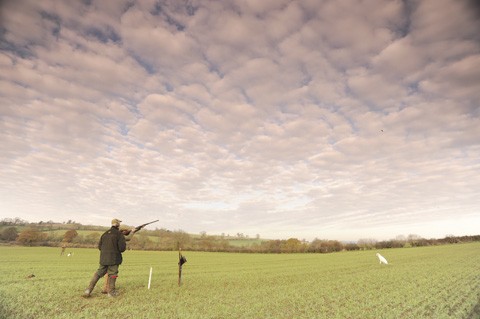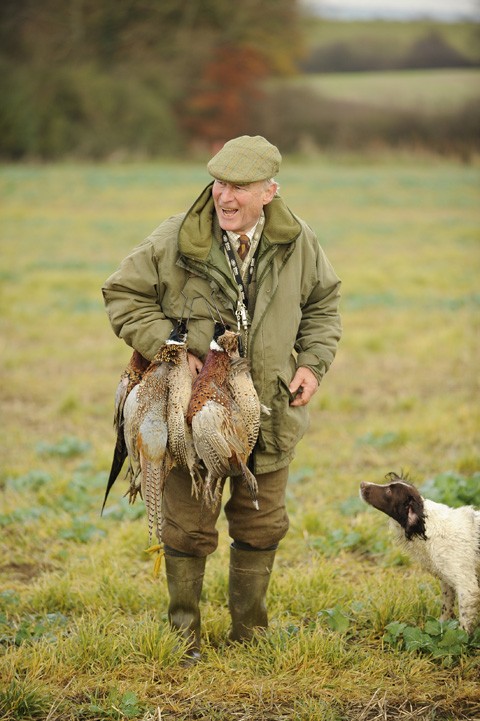Pheasant shooting at Washbrook Farm, Northants

Ever wondered what Britain’s top event riders and trainers get up to when their season finishes in October?
“Shooting. Lots and lots of shooting,” explained host Nigel Taylor as he handed round bacon rolls to the guns.
“It is the perfect winter sport for eventers as it doesn’t involve horses!”
Every season Nigel and his wife, Ann, put on a special day to thank everyone who has assisted with their award-winning horse trials in Aston-le-Walls, which are held every August at their 150 acre Northamptonshire family home, Washbrook Farm.
However, the shoot itself covers 800 acres, with the goodwill of local farmers who have their own day in return.
The shoot day sees some of the most well-known industry figures attend, including Zara Phillips’ father Captain Mark Phillips and former Olympic rider Gary Parsonage.
Nigel originally formed the shoot in 1995, and now lets 10 days a season offering bags between 75 and 225 birds.
Rather unusually, the pegs for each drive are placed around the farm’s world-class cross-country course and alongside Olympic-standard dressage ménages.
 Pheasant shooting at Washbrook Farm, Northants.
Pheasant shooting at Washbrook Farm, Northants.
On the hunt for game
One of the most significant things about this shoot was that one of the masters of the Bicester & Whaddon Chase, Robert Thame, was pheasant shooting the first two drives.
“The hunt and shoot are then meeting for elevenses together,” said Nigel as he picked out his wellies from the dozens piled up by the backdoor. “It is an historic moment for the local area and it is imperative the two sports support each other.”
As we made our way to the first drive, lifelong shooter and professional polo player Robert described the collaboration as a “celebration of fieldsports.”
Dressed in a smart white stock and tweed hunting jacket with gold buttons, Robert eagerly joined the other guns for the Railway North drive which saw the guns lined out on a muddy field of young rape.
International eventer Emily Lochore took the first shot of the day, felling a cock pheasant gliding on an easterly wind from a strip of maize cover crop.
The drive produced steady waves of strong flying, mature birds and provided challenging sport for all 10 guns.
Halfway through the drive a shaggy-looking dog fox bolted from the cover crop, defiantly trotting past Robert’s peg.
“He’s as bold as brass!” quipped Robert as we watched the fox disappear under a blackthorn hedge.
As I watched the guns, I saw guest picker-up Jo Cockerill send her steady black labrador, Jet, to the far edge of the field to retrieve fallen birds.
“I never need to direct him on to game; he has a remarkable ability to mark birds,” beamed Jo.
Also looking for picking-up opportunities was Major Dicky Waygood’s lurcher, Tatty.
“She’s a greyhound cross deerhound and shouldn’t theoretically be interested in this type of work – but she is soft mouthed and retrieves directly to my hand,” said Dicky, adding that his Boykin spaniel could learn a thing or two from his lurcher.
After achieving the prestigious title of Riding Master for the Household Cavalry, Dicky now works as the Chef d’Equipe for the two star European Eventing Championships and was recently nominated for the Queens Award for his outstanding contribution to the equine world.
“I have ridden from an early age,” he explained, adding that shooting is also one of his great loves. “My father and brother are both gamekeepers, and I normally shoot around 30 days a season.”
Dicky’s enthusiasm for shooting showed as he bagged several right-and-lefts.
With the help of some of the locals, Nigel mostly keepers the shoot himself.
Today it was the turn of 19-year-old William Phayer who had been assisting Nigel for the last six weeks.
His role was to coordinate the beaters, while Nigel placed the guns on each of the drives.
Before we knew it, the excitement of the first drive was over.
 John Lawrence was an entertaining presence in the picking-up line.
John Lawrence was an entertaining presence in the picking-up line.
Nigel blew his whistle to end the drive and we made our way back to the cars for the second drive of the day – Pond Hole.
After the guns had deciphered their next peg numbers I followed Will Connell, performance director for the British Equestrian Federation, to peg number five.
With Boddington reservoir to our left and a line of tall poplars in front of us, Will was feeling optimistic.
“In the past, this drive has been a great success,” said Will as he unfolded his shooting stick.
Dozens of songbirds poured out of the woodland before the familiar call of pheasants could be heard.
Then, against an azure sky of wispy altocumulus clouds, the birds broke from the cover.
To Will’s right, Dutch rider Eddie Stibbe was also demonstrating a natural aptitude for the sport.
Emily Lochore again showed that she is as comfortable competing on horseback as she is wielding a shotgun.
“Emily is renowned for her shooting prowess,” whispered Will with a smile.
After the drive had come to an end, Emily told me she been pheasant shooting on the Washbrook Farm & Chattercote Priory shoot for the past 10 years, “It helps to know what to expect from each drive,” she said.
The next drive was Frusher’s Hill, named after David Frusher who owns the land and is himself a keen game shot.
For this drive the beaters blanked in from half a mile away.
“We quietly tap it through and will often flush snipe and wild mallard,” said Nigel, adding that there are a total of 22 different drives to choose from.
He explained that the shoot has always sold itself. “I have never advertised the shoot, it has always been sold through word of mouth or repeat custom.
We put down several different breeds of pheasant – Japanese greenbacks, French Black Ringnecks and Old English Ringnecks – I find that a mix of breeds guarantees sport for every ability.”
In addition to this melting pot of breeds, Nigel also released 85 white pheasants to act as markers.
“It was shocking how much the birds wander,” he said, adding he has since put down more feeders. “I can highly recommend releasing white pheasants – it is incredibly useful to discover where your birds actually end up.”
A meeting of minds
As planned, the guns and hunt both met for elevenses back at the house.
Mounted on his smart bay horse, Robert Thame made a toast to mark the occasion before the guns were ushered on to the next drive, Bomb Hole.
As the signature drive it is a pheasant haven, providing warmth for game birds under its dense bramble.
Standing between Michael Mac, chairman of British Showjumping and Captain Mark Phillips, made for some exciting spectating.
Despite facing into the sun, Michael and Mark were equally competent when it came to pulling down the birds.
 Captain Mark Phillips had a good day with the whistle and gun.
Captain Mark Phillips had a good day with the whistle and gun.
Mark’s three-year-old yellow labrador, Willow, lay silently and perfectly still on the grass in front of him for the entire drive.
“She was trained by the headkeeper at Windsor, John Stubbs. I’m better at training horses than I am dogs,” said Mark. “However I get as much pleasure from working my dog as I do pheasant shooting.”
Mark spends most of his time coaching the American Olympic team and running the annual Festival of British Eventing every August at Gatcombe Park in Gloucestershire.
After a slight amendment to the pheasant shooting line position to accommodate a change in wind direction, the drive was a huge success.
I witnessed Mark’s neighbour, Richard Wright, spectacularly shoot a snipe that tried in earnest to jink its way between the guns.
Hitting the heights
The penultimate drive of the day took place on a field of young beans.
By now the sun was starting to set, giving the sky a lovely orange and pink wash.
Olympian Gary Parsonage from East Yorkshire was on the end of the line.
“It does not make any difference that I am the last peg. Every other time I have shot this drive it has produced sky-scraping birds,” said Gary, who is also a keen stalker. “I find shooting provides me with a real escape from work and horses.”
Before the final drive of the day the guns and beaters were treated to some refreshments.
I took advantage of the break to chat to British Eventing’s Chris Hunnable.
“I’ve had some fantastic sport so far today,” he enthused.
 Ben Taylor, Phil Surl and Sam Hunnable are regaled by Chris Hunnable after a successful drive.
Ben Taylor, Phil Surl and Sam Hunnable are regaled by Chris Hunnable after a successful drive.
“This special day for eventers is legendary throughout the industry, there are many competitors that would like to come along!”
Fortified by champagne and chocolate biscuits the guns prepared for the duck drive.
By now, the temperature had plummeted and the cold air was numbing fingers and toes.
“The north wind doth blow, and we shall have snow,” remarked Nigel as I blew into my cupped hands.
Gun Philip Surl who, after a successful career competing at some of Britain’s toughest eventing courses is now the eastern regional coordinator for British Eventing, lent Nigel’s young son, Neil, his gun for part of the drive.
Neil shot several ducks stone dead, which wasn’t much of a surprise, as Neil and his twin brother Ben are the current National Prep School clay pigeon shooting champions.
A last chance for glory
Just as we thought the day was over, Nigel revealed he was going to do one last drive.
I stood behind Richard Wright and his deaf springer spaniel.
“The vets are unsure why she has lost her hearing. But I have a feeling that spending every summer shooting hundreds of pigeons from a small hide may have something to do with it,” he confessed.
As chairman of the GWCT’s Northamptonshire committee, Richard is a keen shot.
“I shoot between 20 and 30 days a year,” he revealed.
Dotted around us were various lethal-looking cross-country jumps including a ‘coffin’, ‘dog house’ and the rather aptly-named ‘pheasant feeder’.
“It always seems strange to walk the course in preparation for the horse trials in May, having fond memories of pheasant shooting around the jumps the previous November.”
 International eventer Emily Lochore goes after a high pheasant.
International eventer Emily Lochore goes after a high pheasant.
As husband of top class eventer Christine Lomax, Richard is well-versed with the sport.
“However I tend to spend most of my free time with a shotgun in my hand.”
After spending the day with this group of multi-talented guns I left feeling inspired.
Far from being one-trick ponies, Nigel’s guests can not only ride at the highest level, but they can also shoot straight.
This shoot is a brilliant way to enjoy well-presented birds at an affordable price.
The final bag was 148 pheasant, 102 duck, five partridge and a snipe – rather impressive given the party the night before was still going at 4am!
If you are looking for a slightly unusual venue for next season, it is well worth considering a day on Aston-le-Walls.
For more information on the shoot click here
For more shoot features click here








